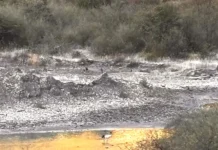Monday Musing
[ M Doley ]
Housefire is one of the worst manmade disasters. It causes irreversible damages. Apart from property losses, the affected people suffer from hopelessness, shock, depression and anger after losing their homes.
A massive fire had destroyed more than 100 dwellings in Longliang village in Tirap district last year. The fire rendered hundreds of people homeless on the night of 18 March.
The affected people are still feeling the trauma of having their homes destroyed. Their miseries have not ended yet. The fire victims are still living in temporary houses due to the delay in the reconstruction of their houses.
Longliang village gram panchayat chairperson Sethok Hodong said: “Foundation for around 20 houses only could be laid so far due to bad road condition to transport the construction materials.”
The fire in Longliang had devoured 114 houses out of the total 139 in the village. Two persons, including a child, were killed in the fire.
In another fire mishap in January last year, three children were charred to death in Tapirijo village in Kamle district.
In February this year, 30 shops and private residences were reduced to ashes in a devastating fire incident in Daporijo in Upper Subansiri.
Fire accidents may occur anytime, anywhere, throughout the year. However, it is observed from the previous incidents that most of the major fire mishaps occurred during the dry winter season.
In most cases, electric short-circuit is blamed for the housefires in Arunachal.
An electric short-circuit may occur due to overloading of electric current in the circuit, faulty wiring, faulty plug, faulty power cord and substandard and outdated electric appliances.
Unattended fireplace, unattended cooking, unattended burning candle, discarded cigarette butts by careless smokers and children playing with fire are some of the main reasons of housefires.
Fire due to natural forces like lightning seldom occurs. A couple of days ago, a fire incident due to lightning was reported from Mariyang subdivision in Upper Siang district.
In many cases, narrow road or inaccessibility acts as the major impediment to movement of fire tenders, leading to an increase in the amount of damages. Besides, the traditional thatched houses in the villages are built close to each other, due to which fires can spread easily to the nearby houses. So, the people should take this into account while constructing houses.
On the other hand, prompt response to fire calls by the fire brigades can save lives and prevent loss of properties. Absence of fire stations in some districts is also a major cause of concern.
Siang, Shi-Yomi, Kamle, Kra Daadi and Pakke-Kessang still have no fire station, sources said.
As per a source, the fire & emergency services department currently has a little over 87 fire tenders, including 16 advanced fire tenders, six foam fire tenders and 23 quick response vehicles (QRV) in its fleet. Of them, at least 10 fire tenders, besides a few QRVs, went off the road.
The authority should strengthen the fire & emergency services department by inducting more fire tenders and manpower to its fleet, apart from creating mass awareness about fire safety tips and preventive measures.
Since prevention is better than cure, the people should exercise utmost care and take precautions while handling fire and flammable items to avoid housefires.



